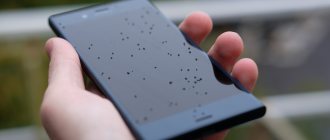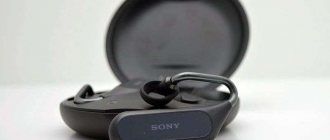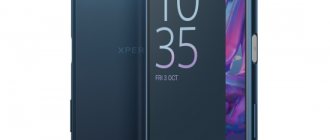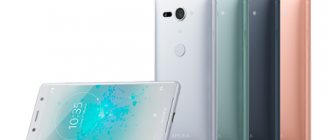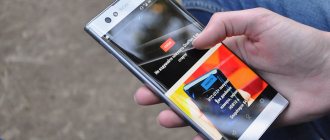The Sony Xperia E smartphone is usually classified as a budget smartphone. In the Dual modification it supports 2 SIM cards. The smartphone is positioned as the optimal solution for people looking for a compromise between functionality and affordable price.
There is a version that Sony Xperia E is a technological continuation of several platforms that became famous in past years (when classic phones were still popular). In particular, we can talk about the Walkman brand, which has become very popular among music lovers from all over the world. Some experts believe that some of the solutions characteristic of this media platform were in one way or another transferred to mobile devices from Sony. We will try to understand today whether this is so.
Does the Sony Xperia E smartphone in the classic version differ from the phone in the Dual version in anything other than the number of supported SIM cards? Almost nothing. The only thing that may not be the same is the colors of the cases supplied to markets around the world. Functionally and from a technological point of view, these devices, apart from the aspect with SIM cards, are identical.
In our review today we will consider both devices as one phone model. There is another popular modification of the smartphone - Sony Xperia E Dual Champagne. This device differs from its counterparts in its special body color, called “champagne” in the French manner (as a rule, it refers to soft yellow-orange tones). Similarly, there is a device in a black case (in which case it will be called Sony Xperia E Black).
Appearance
Experts who tested the device note its high-quality design. Along the edges of the case there is an elegant border in the form of a frame in silver shades. The power button of the device gives a special highlight to the design: it is made of metal, and it looks very stylish. The edges of the body are slightly rounded.
The screen of the device is relatively small (3.5 inches), the voice speaker is covered with a neat thin mesh. At the bottom is a microphone, and next to it are three standard touch keys - “Menu”, “Return”, “Home”. The LED indicator signals incoming messages or calls.
On the right side of the case there is a key that regulates the sound level, next to it is a button to turn on the device. There is also a switch for quickly loading the standard camera. On the left side of the case there is a microUSB connector. At the top there is a slot for audio devices.
The back of the case is made of soft and very pleasant to the touch polymer material. It houses the main camera of the device, as well as the main speaker. The latter sounds, as experts note, very high quality. Ring tones can be heard even in noisy surroundings.
Under the back cover, which, by the way, is very easily removed, there are slots for a SIM card (in the Dual version - for two), as well as connectors where you can connect microSD flash memory modules.
The build quality of the case is assessed by experts as very high. There are no backlashes, creaks, or gaps. All parts are fixed in place securely.
Display
The display, whose diagonal is 3.5 inches, has a resolution of 480 by 320 pixels. Matrix manufacturing technology - TN. The screen is covered with a durable layer of plastic. The multi-touch function is designed for one or two touches. Some experts believe that the screen resolution is too small, and therefore the pixelation of the screen will be noticeable. In addition, supporters of this thesis believe that a TN-type matrix cannot provide large viewing angles. This is also said by some Sony Xperia E users, whose reviews can be found on the Internet.
Screen technologies: classic or modern?
There are also those who are ready to provide counterarguments to critics. They believe that very high levels of energy savings are achieved through relatively outdated (but at the same time respectable traditional) display technologies. In addition, they believe that the small dimensions of the smartphone, and, as a result, the relatively small diagonal of the screen, do not allow viewing images in detail. Therefore, there is no point in equipping the device screen with a more modern matrix. There is no clear opinion regarding the display. For every characteristic that highlights the disadvantages of the Sony Xperia E screen (the device is reviewed in the article), there is a selection of balanced and compelling arguments reflecting the positive aspects of this component of the device.
Software
The smartphone runs Android OS version 4.0.4. It has proprietary firmware from the manufacturer installed, as well as a fairly large number of pre-installed applications. Among the most useful are the address book, a virtual keyboard (supporting, in particular, entering letters using the “strokes” method on the screen), as well as widgets (showing the weather, time, allowing you to make phone calls, quickly finding the desired contact). There is a convenient browser and multimedia player.
Performance
The Sony Xperia E smartphone has a single-core MSM7227A processor with a clock frequency of 1 GHz. The amount of RAM is 512 MB. Pre-installed flash memory - 4 GB (actually 2 available). There is support for external microSD cards up to 32 GB. Experts who tested the smartphone note that, in general, the device works quickly. There are minimal freezes and slowdowns in operation.
The rather modest capabilities of the processor and not the largest amount of RAM allow you to run only simple games on your smartphone (such as, for example, Fruit Ninja). At the same time, experts believe, on the screen that the device has, playing “shooting games” and “quests” would even be inconvenient. Therefore, limited performance, they believe, cannot be a significant disadvantage in terms of device functionality.
Sony Xperia E Dual review
In the Android smartphone market, Sony prefers to play in the upper price segment. Our guest today, the Sony Xperia E Dual, is one of the few exceptions to this rule. Let's see what Sony's dual-SIM budget phone is capable of.
Specifications
Our guest is a typical representative of the lower price segment, not particularly different from competing solutions. It is equipped with a single-core Qualcomm MSM7227A (Cortex-A5) processor with a clock speed of 1 GHz, also known by the beautiful name Snapdragon S1. Together with the heart of the smartphone, such vital organs as the Adreno 200 graphics accelerator work; 512 MB RAM; and a built-in storage capacity of 4 GB, of which only half is available to the user. The performance of the device is at the level of last year’s middle-class models.
The smartphone is equipped with a very modest camera for today's times with a resolution of 3 MP, devoid of LED backlight and autofocus. It does not have an additional camera for video calls at all.
The operation of two SIM cards is ensured by one radio module. This means that both cards work in standby mode, and during a conversation or using the Internet from one number, the second one will not be available. However, this solution has one undeniable advantage - lower energy consumption. Thus, a smartphone with a not very capacious battery (only 1530 mAh) manages to finish an active working day with a small amount of charge left.
| Sony Xperia E Dual | |
| operating system | Android 4.0.4 |
| SIM card | “standard” SIM (2FF), two |
| Display | TFT, 3.5 inches, 320x480 pixels, touch (capacitive matrix) |
| Dimensions and weight | 113x62x11 mm, 116 g |
| CPU | single-core, Qualcomm MSM 7227A Snapdragon S1, clock frequency 1 GHz |
| RAM | 512 MB |
| Flash memory | 4 GB (2 GB user available), support for memory cards up to 32 GB |
| Camera | 3.2 MP, video recording 640x480 |
| GPS | Yes |
| Battery | 1530 mAh |
Appearance
In terms of design, the Xperia E Dual is a copy of its fellow newcomers, but in a smaller body. At arm's length the device looks beautiful, especially in the champagne color. The glossy surface on the front is diluted only with light symbols of the touch keys and the inscription “Sony”. The idyll of the shiny plane is broken only by the cutout for the earpiece on top, as well as the microphone on the bottom.
The left side, traditionally for a Japanese company, is free of any keys; it houses only a micro-USB port for a charger and data exchange.
The right one is replete with control elements: volume keys, a power/lock button (made of metal), and a camera key. All of them have a clear, albeit slightly tight movement.
The bottom end is empty, and the top has a headphone output.
The back side of the “E-shka” is decorated with an embossed pattern. This plastic is matte and does not collect fingerprints, but upon closer inspection, strong doubts arise about the high quality of this material. So as not to go around in circles, I’ll say frankly that this is the ugliest part of the body when you get to know it up close and at the same time the most beautiful when you get to know it from afar.
There are three holes in the back cover - one for the camera eye, the second for one of the microphones, and the third for the speaker covered with a metal grille.
The hole for the camera is not covered with anything, and there is a noticeable gap between the boundaries of the hole and the camera module itself. If the manufacturer wanted to make a kind of pocket vacuum cleaner, then he succeeded. In one day, dust accumulates inside the case, not to mention the eye of the photo device.
When looking at the smartphone, it seems that the lower part of the back cover is removable and gives access to two calling cards and one memory card. This feeling is enhanced by the tighter fit of the top to the rest of the body.
The top part is actually removed. The lid fits tightly, but has slight creaking when pressed in the area of the hole for the camera.
Having pressed in the area of the hole for the headphone plug, we find that the plastic in this place has a movement close to that of the volume keys on the right edge of the device. When you first become acquainted with this defect, you get the full feeling that there is another button built into the case, a la Blackberry.
Performance and autonomy
The hardware of our budget device is frankly weak, so there is no point in commenting on the test results.
As mentioned earlier, the smartphone is able to easily get through a working day with an average load. This is an hour of talking, an hour of Twitter or another social network, an hour and a half of Angry Birds or any simple casual game - and by the end of the evening there will still be a little charge left to spare. If you use the Xperia E Dual as a device exclusively for calls, then the smartphone will last 2-2.5 days.
Display
Back in the distant 2005s, a 3.5-inch diagonal phone screen could scare those around you, but now you can scare those around you with a resolution of 320x480 pixels and TFT matrices, which Sony still does not want to replace with more energy-efficient and eye-pleasing IPS. Yes, the Bravia Engine image enhancement software is built into the smartphone's operating system, but it does not solve the problems inherent in TN+Film panels. Vertical viewing angles are good, but information in the sun is almost completely unreadable even at maximum brightness. The situation is aggravated by the millimeter distance between the protective layer of the screen and the matrix itself. And this is not to mention the huge frames around the display.
Camera
The 3-megapixel module, devoid of autofocus and flash, produces corresponding results. The picture comes out blurry and with slightly distorted colors. The number of settings is also minimal, it is limited to the ability to select a shooting mode (“Night shooting”, “Sports”, etc.), as well as exposure compensation. You can see examples of pictures in a separate gallery.
Competitors
Xperia E Dual has more interesting competitors for the same money. The price of the device at the moment looks overpriced. In terms of class, the smartphone is approximately at the level of the LG Optimus L3 II Dual. The Xperia E Dual has a slightly larger display, which is made using outdated TFT technology, and a less powerful processor, but this does not prevent it from costing more. With such a price tag, you should turn your attention to more successful models from competing companies. All have high-quality IPS displays, cameras with autofocus and larger batteries.
QP.UA [buy] - Buy in Ukraine: TVs, cameras, monitors, laptops and netbooks, Internet tablets and e-books.
Bottom line
The Sony Xperia E Dual is the most ordinary budget smartphone, the only justification for its existence is the ability to work with two SIM cards, and the most serious drawback is its inflated price. (It is worth noting that this is generally typical for Sony products officially supplied to our market.) So we can recommend or pay attention to alternatives, or try to find a smartphone from “gray” supplies, or wait for a price reduction.
3 reasons to buy Sony Xperia E Dual:
- Design
- Key layout
- Call speaker volume
3 reasons not to buy Sony Xperia E Dual:
- Creaking body
- Camera without autofocus
- Back cover design
Battery
The battery capacity of the smartphone is 1.5 thousand mAh. It lasts for about a day with average intensity of use (about half an hour of talking, 120 minutes of Internet use and the same amount of listening to music). As with other hardware components found on the Sony Xperia E, there are two main schools of thought when it comes to battery life. The first one says that the battery is very weak. The second is that a device of this class with such modest dimensions should not have large battery life.
Design and appearance
Sony Xperia E5, as the name suggests, continues the budget E series. However, it is not very similar to the previous Xperia E3 and Xperia E1. You could even say that it is more reminiscent of the recent Xperia X. The E5 comes in two colors - black and white. Its front panel is completely covered with glass, so it is glossy, and the side edges and back panel are matte, velvety to the touch.
There are exactly three buttons on the right side: two are responsible for adjusting the volume, and the third is the power and lock key. These controls are located in the usual places, namely in the upper third of the body. Sony has experimented a bit with button placement in other devices (for example, the Xperia X and X Performance had the volume rocker at the bottom right), but the Xperia E5 is more traditional in this regard.
On the left side there is a flap, under which there are connectors for a nanoSIM format SIM card and a microSD memory card. The top end contains only a mini-jack for connecting headphones or a headset, and at the bottom there is a microUSB port for connecting a charger and data cable.
Five-inch screen, IPS matrix, resolution – 1280×720. The dot density, at first glance, is not great - only 294 ppi. However, in practice, individual pixels are not visible to the naked eye. The display is just as comfortable to use as in the case of the Sony Xperia XA. Note the high brightness and contrast - the screen allows you to read text in clear sunny weather.
The plastic case made it possible to make the smartphone quite light - it weighs only 147 g. Budget devices are often not assembled in the best way; increased gaps between components, noticeable play and creaking when squeezed are not uncommon. In the case of the Xperia E5, none of these problems appear - the panels fit tightly, there is no movement, and when trying to squeeze or twist the smartphone does not make any sounds.
Camera
The Sony Xperia E smartphone is equipped with a camera with a resolution of 3.2 megapixels. There is no autofocus, but there is another useful function - a separate key for releasing the shutter. Using the camera, you can shoot videos with a resolution of 640 by 480 pixels. Assessments of the quality of multimedia files created using a smartphone vary greatly among experts. Some experts, writing a review of the Sony Xperia E, preferred to focus on the fact that the camera on the phone is of an average level. In their opinion, the quality of pictures taken using the device cannot be compared with that shown, in particular, by ordinary amateur cameras. Not to mention specialized cameras.
But for those who criticize the device’s capabilities in terms of creating pictures and videos, opponents find a compelling counterargument: a smartphone (especially in the budget price category) is, first of all, a device for working with data, and not a producer of professional photo and video content. In addition, camera “advocates” believe that if you don’t pick too much on color balance and brightness, then the quality of the images is generally good.
Results
The Sony Xperia E Dual smartphone has acquired all the features in order to be considered an improved version of the Sony Xperia tipo Dual. This includes a larger screen, an updated hardware platform, a more capacious battery, and, as expected, it turned out to be more expensive. The only thing where the smartphone showed good results was the operating time, and then with some reservation. If we manage to understand what gives such contradictory results and achieve stability, the smartphone can be recommended to those who do not expect something impossible from a mobile phone, preferring good autonomy, design and support for two SIM cards.
If we talk about competitors, then of the latest smartphones we tested, the LG Optimus L3 II Dual comes to mind. It also has a stylish design, good battery life, a 3 MP camera, a comparable hardware platform and camera, but a lower screen resolution. The price is also significantly lower. If we consider more expensive devices, then the closest in price will be the Fly IQ442 Miracle. It has a bigger and better screen, a dual-core processor and a 5 MP camera with HD video recording, but the design is not the kind that makes you want to buy the device.
Liked + Support for two SIM cards + “Automatic selection” menu in the SIM card settings + Autonomy + Availability of a hardware camera key + Availability of an indicator for missed events
Didn’t like it - Lack of autofocus in the camera - Lack of flash - Lack of light sensor - Output on an outdated version of Android - Display brightness indicators
| Sony Xperia E dual (Black) Notify when available | |
| Type | smartphone |
| Type of shell | monoblock |
| Standard | GSM 850/900/1800/1900, UMTS 1900/2100 |
| High speed data transfer | GPRS, EDGE, HSDPA (up to 7.2 Mb/s), HSUPA (up to 5.76 Mb/s) |
| Dimensions (mm) | 113,5×61,8×11 |
| Weight (g) | 115,7 |
| Processor (for smartphones) | Qualcomm MSM7227A Snapdragon (Cortex-A5), 1 GHz + GPU Adreno 200 |
| Memory | 512 MB RAM + 4 GB internal memory (up to 2 GB available to the user) |
| Expansion slot | microSD (up to 32 GB) |
| Main screen | TFT, 3.5″, 320×480 pixels, 262 thousand colors, touch, capacitive, multi-touch support, |
| Keyboard type | screen input |
| Accumulator battery | Li-Ion, 1530 mAh |
| Operating time (manufacturer's data) | conversation - up to 6h12m/6h18m (2G/3G), standby - up to 530h (2G/3G) |
| Communications | USB 2.0 (micro-USB), Bluetooth 2.1+EDR (A2DP), WiFi 802.11 b/g/n, DLNA, Wi-Fi hotspot |
| Supports 2 or more SIM cards | + |
| Photography | 3.2 MP, digital zoom |
| Video shooting | 640x480 pixels |
| Flash | — |
| FM radio | yes (87.5-108 MHz, RDS support) |
| Additional features | media player, a-GPS receiver, synchronization with Google services, accelerometer, integration with social networks, work with office documents, light and proximity sensors |
Summary: What the Experts Say
In general, the mood among the specialists who tested the device is such that the device corresponds to its budget level. The manufacturer brand did not put a lot of hardware and software resources into it to achieve excessively high performance, based on the specifics of the market segment in which the device is sold.
The most important advantage of the device, which is noted by experts, is the security of the case. The materials used to make the smartphone are of very high quality. Therefore, the phone has good resistance to aggressive elements of the external environment - dust, humidity, temperature changes.
Most experts agree that the characteristics, functionality, and performance resources laid down by the developers of the Sony Xperia E generally meet the needs of budget segment users. Experts believe that the device could well become one of the most popular in its class.
The device doesn't have many direct competitors. For some, it is objectively inferior, but in the case of Sony, the brand may be of decisive importance for the buyer. There is a version that fans of the manufacturer should be happy with the device. In this regard, Sony has equipped the device with all the necessary options: proprietary design, branded and easy-to-use software.
⇡#Camera
When the Sony Xperia 1 II was announced, the creators of the smartphone placed great emphasis on its cameras, but there was no serious leap in relation to the Xperia 1.
Unlike its predecessor, four cameras are installed here, but only three are constantly involved in the process, receiving 12-megapixel sensors, unexpected for a world where Quad Bayer rules the roost. The main camera, along with a 1/1.7-inch sensor, received a lens with an equivalent focal length of 24 mm and an aperture of ƒ/1.7, with optical stabilization and phase detection autofocus with Dual Pixel technology. The telephoto lens is characterized by almost three times the focal length (70 mm equivalent) and an aperture ratio of ƒ/2.4 - there is progress here compared to its predecessor. This camera also uses optical stabilization and Dual Pixel phase detection autofocus, and the sensor is noticeably smaller - measuring 1/3.4 inches. The third lens is an ultra-wide-angle (16 mm, with increased aperture ƒ/2.2), without stabilization, but with autofocus; sensor - 1/2.4 inches.
| From left to right: shooting at a wide angle, with a standard focal length and with a 3x zoom | ||||
As you can easily calculate, three cameras allow you to take pictures at three focal lengths with optical zoom, without obvious losses in quality - and the wide-angle camera demonstrates itself as confidently as possible: the picture during the day is not inferior to that obtained from the main camera; at dusk and at night it is already noticeably inferior, but the module remains working. In addition, autofocus allows you to use a wide-angle camera not only for general landscape plans, but also for interesting options with other scenes - for example, for dynamic long-range portraits.
Moreover, the emphasis on autofocus concerns not only and not so much the wide-angle camera, but others - here Sony used its vast experience in creating full-size cameras and equipped the smartphone with the most powerful focusing system with eye recognition (works for both people and animals) and tenacious tracking autofocus (quite good). It is also possible to shoot at maximum resolution at speeds of up to 20 frames per second, including in RAW format. All this is very cool, along with a special built-in application for “professional” shooting, which differs from the usual application with “manual” settings only in design and - for some reason - the inability to flip the interface into a vertical format.
The emphasis is on “seriousness” and on experienced photographers who are accustomed to keeping the process under complete control. But in this case it is largely marketing. Firstly, the genre of mobile photography itself rarely requires carefully checking the smallest details - but okay, there are amateurs. Secondly, this does not require a special menu designed in the manner of Sony Alpha cameras - on the contrary, it is wrong to copy the cumbersome interface of cameras that have long lagged behind smartphones in this regard. The only real advantages seem to be powerful autofocus and burst shooting, but then again, who seriously uses a smartphone as a camera for dynamic shooting? A dubious idea, although the Xperia 1 II is best suited for working with children and pets.
Example of shooting with a shutter speed of one second
But with the increase in the number of possibilities for “manual” shooting control, several “smart” modes, which are basic for a modern smartphone, have fallen out of the socket. And if I probably won’t be sad about the help of “artificial intelligence,” then the lack of a special night mode with multi-frame exposure greatly impacts the capabilities of the smartphone. Yes, for example, it allows you to take a high-quality shot with a one-second exposure (if you lean your hands on some kind of fence), but it cannot replace the full-fledged night mode, which is found on almost all modern smartphones. However, the night mode, in fact, is there, it’s just that the smartphone itself decides when it is necessary to lengthen the shutter speed to a couple of seconds - you cannot control the process. In general, the quality of shooting on the Xperia 1 II at night does not give rise to serious complaints: you can get an unblurred frame with acceptable detail even at different focal lengths - but still, here the Sony flagship is inferior to all competitors.
Another cornerstone of modern mobile photography is portrait mode. It is available only for photos, while the Xperia 1 II cannot do video with background blur, despite the presence of a TOF module. And it copes quite well with photos - for this you need to activate the “bokeh” mode; there is no special portrait mode in the shooting application.
| Sony Xperia 1 II camera application interface | ||||
Overall, though, the shooting app is a bit of an oddity - it's unchanged from what we saw last year and offers quite a few options in its basic format. You have to go to a special submenu to find them, and to activate Pro modes, you actually need to turn on separate applications, which take time to access. It is not clear why it was done this way and not by integrating it into one application. Navigation is also not the most convenient, but switching between focal lengths is implemented correctly, and not like, for example, Huawei.
Among the software features of the Sony Xperia 1 II camera, I will note specific filters that were invented specifically for the smartphone, and were not moved here from Sony Alpha; Most of them look downright strange, but there are also original ones - like the kaleidoscope effect. Moreover, the filters work for both photos and videos.
The overall impression of the Sony Xperia 1 II as a camera is ambiguous: on the one hand, there is a good stabilizer, excellent (probably really the best on the market) autofocus, fast continuous shooting and an emphasis on manual control, on the other hand, the shooting quality is not the best for a modern flagship the highest level (the white balance fluctuates a little from focal length to focal length, the dynamic range is not maximum, the detail is average), there is no night mode. But those who like complete control without the intervention of sometimes overly intrusive neural networks will like the Xperia 1 II.
A special mode has also been prepared for video shooting, but to a large extent we have already seen it before: special “cinema” filters (the so-called LOOK color correction templates), full control over various parameters (from white balance to microphone levels and FPS) - and here as since the horizontal orientation is quite logical; stories can also be recorded in a regular application. Video recording in 4K resolution at 60 frames per second in HDR format is supported, there is an effective stabilizer that works quite successfully with 4K. But - and this is strange - with the said 4K 60p claim, the stock app only supports up to 30fps in 4K. The picture is high quality, without the rolling shutter effect. But slow-motion video, which was once a signature feature of Xperia, is unfortunately limited to a speed of 120 frames per second - the Japanese did not chase competitors who have already reached exorbitant speeds (7680 frames per second on the latest Huawei flagships). But in general, the Xperia 1 II is in perfect order with video shooting.
The front camera is standard - 8 megapixels (dimensions - 1/4 inch), aperture - f/2.0, without flash and autofocus. The focal length is normal, distortion is at an acceptable level, and there is a blur mode. Selfies come out pretty good.
User opinions
Let's consider the opinions of Sony Xperia E owners, whose reviews can be found on online portals. Most smartphone owners talk about it as a device that lived up to expectations. Many note the high quality of the case materials, ergonomics, and the beauty of the device’s design. By the way, in the user environment there are small reports of attempts to run games on smartphones that are a little more complex than Friut Ninja - those that use complex animated 3D graphics. According to many phone owners, the device, despite the modest characteristics of the processor and RAM, coped well with gaming tasks.
Users note the high build quality that characterizes the Sony Xperia E smartphone. Feedback from owners in this regard is very positive. This criterion is apparently one of the most undeniable in terms of studying the capabilities of the device. Almost all experts also noted the fact that the device was assembled very well.
Many users note the convenience and comfort of using multimedia programs, which is not surprising: since the release of devices from the legendary Walkman brand, Sony has been paying great attention to the development of technologies designed to increase comfort when listening to music.
Hardware platform
The model runs on a single-chip system-on-chip Qualcomm Snapdragon S1 – MSM7227A, which includes a Cortex-A5 processor with a clock frequency of 1 GHz, an Adreno 200 graphics core. The amount of RAM and permanent memory is 512 MB and 4 GB, respectively. Of the 4 GB, just under 2 GB is available to the user.
This SoC is installed on the vast majority of non-Chinese smartphones with support for two SIM cards. Two or three years ago it was considered a sign of a middle-class device.
It would be wrong to want anything other than good autonomy from a smartphone equipped with a Qualcomm MSM7227A chip, although for 1,600 hryvnia you can find devices with a more powerful processor and graphics core, for example, based on MTK6577.
We didn't even try to run Full HD video on a smartphone, it's just pointless. Videos with a resolution of up to 1280x720 pixels inclusive also did not respond to the built-in player, and only installing a third-party one improved the situation somewhat. The user can count on more or less smooth playback of video with a resolution below HD. For example, a video file in an AVI container with a resolution of 1280x536 pixels and a bitrate of 2.8 Mbit/s was played quite well by MX Video Player.
The sound volume when watching videos is average; for comfortable viewing in noisy rooms, we recommend using vacuum headphones.
The sound volume when listening to music is also average, although higher than when watching videos. The sound can be described as good.
Estimating the operating time of the Sony Xperia E Dual turned out to be a difficult task. With two SIMs installed, the smartphone could work for up to four days, and could be discharged by 30-40% overnight. The same applies to indicators of operating time in player or navigator mode. In the first case, after 4 hours of music (one SIM card, without Wi-Fi, data transfer, GPS, display brightness 50%), the smartphone was discharged by only 6%, which is equivalent to 66 hours and 40 minutes of operation. At the same time, starting navigation in 8 minutes drained the battery by 14%. In the Antutu Tester application, Sony Xperia E Dual scored 1233 points. The indicator is more than excellent. It is quite possible that with the transition to a new version of the operating system, the problem with the unclear battery life will be eliminated. If so, the Sony Xperia E Dual could be one of the longest-lasting devices of its kind.

